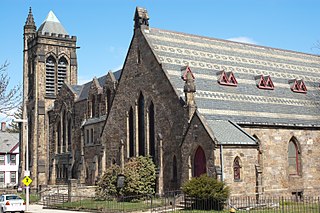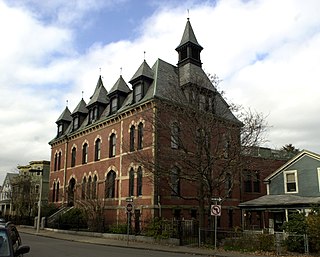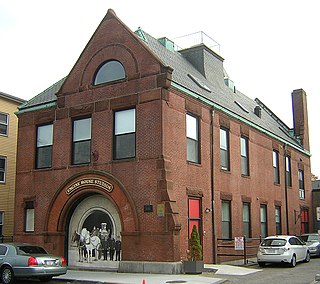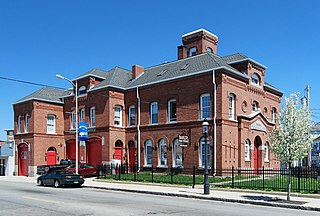
Alewife Brook Parkway is a short parkway in Cambridge and Somerville, Massachusetts. It is listed on the National Register of Historic Places. It begins at Fresh Pond in Cambridge, and heads north on the east bank of Alewife Brook, crossing into West Somerville and ending at the Mystic River on the Medford town line, where it becomes Mystic Valley Parkway. The entire length of Alewife Brook Parkway is designated as part of Massachusetts Route 16 (Route 16), while the southernmost sections are also designated as part of Route 2 and U.S. Route 3 (US 3). It is managed by the Department of Conservation and Recreation with the Massachusetts Department of Transportation responsible for bridge maintenance.

Harrison Henry Atwood was an American architect and politician who represented Boston in the United States House of Representatives from 1895 to 1897 and for several nonconsecutive terms in the Massachusetts House of Representatives. He was a member of the Republican Party but was also supported by the Progressive Party during his later terms in the Massachusetts House.

The Chestnut Hill Reservoir Historic District is a historic district encompassing the Chestnut Hill Reservoir and the surrounding water works facilities which were historically used to provide fresh water to Boston, Massachusetts, and surrounding towns. The district is nearly coextensive with the Chestnut Hill Reservation, a state park managed by the Massachusetts Department of Conservation and Recreation (DCR); those elements of the water works that are still required as an emergency backup are managed by the Massachusetts Water Resources Authority (MWRA). The reservoir is located between Beacon Street and Commonwealth Avenue in Boston's Chestnut Hill district, just east of the Boston College Main Campus Historic District.

Wakefield station is an MBTA Commuter Rail station in Wakefield, Massachusetts served by the Haverhill Line. The station has two side platforms, which are not accessible, serving the line's two tracks. The station building, constructed in 1889, was listed on the National Register of Historic Places in 1989 as Wakefield Upper Depot.

The 1767 Milestones are historic milestones located along the route of the Upper Boston Post Road between the cities of Boston and Springfield in Massachusetts. The 40 surviving milestones were added to the National Register of Historic Places in 1971. Massachusetts has a total of 129 surviving milestones including those along the upper Post Road. The stones are so named, despite having been placed in many different years, because of a 1767 directive of the Province of Massachusetts Bay that such stones be placed along major roadways. The state highway department was directed in 1960 to undertake their preservation. Many of them underwent a major restoration in 2018.

The Eliot Congregational Church is a historic Congregational church at 56 Dale Street, at the corner of Walnut Avenue in the Roxbury neighborhood of Boston, Massachusetts.

The Congress Street Fire Station, now known as the Boston Fire Museum, is an historic fire station at 344 Congress Street in Boston, Massachusetts.

The District 13 Police Station is a historic former police station at 28 Seaverns Avenue in the Jamaica Plain neighborhood of Boston, Massachusetts. The Gothic Revival station was designed in 1873 by George Ropes and built for the town of West Roxbury, as one of its last public works before its annexation by Boston. An addition was designed in 1892 by Edmund M. Wheelwright, architect for the City of Boston. The building is one of the only high-style Victorian municipal buildings in the city.

Engine House No. 34 is a historic fire station at 444 Western Avenue near the corner of Waverly Street in the Brighton neighborhood of Boston, Massachusetts. The station, a 2+1⁄2-story brick and brownstone structure, was designed by Charles J. Bateman and built in 1888. It is one of a small number of Richardson Romanesque structures in the neighborhood, and features an engine entrance recessed behind a large round arch set asymmetrically on the main facade. The roof is gabled, although it has a hipped section above, with a large hipped projection to the left.

The Harvard Avenue Historic District is a historic district roughly bounded by Linden Street, Commonwealth Avenue, Harvard Avenue, and Park Vale Avenue in the Allston neighborhood of Boston, Massachusetts. Its spine is Harvard Avenue, a major north–south thoroughfare connecting Allston to points north, and south toward Brookline. The area underwent a population explosion in the early 20th century, and Harvard Avenue was developed roughly between 1905 and 1925 as a commercial and residential spine. Notable buildings in the district include the Allston Station building, designed by Shepley, Rutan and Coolidge, and the Harvard Avenue Fire Station.

The Russia Wharf Buildings are a cluster of three stylistically similar commercial buildings at 518-540 Atlantic Avenue, 270 Congress Street and 276-290 Congress Street in Boston, Massachusetts. They are built on the original site of Russia Wharf, near where the Boston Tea Party took place in 1773. The wharf was the center of Boston's trade with Russia in the late 18th and early 19th centuries. The wharf's buildings were destroyed in the Great Boston Fire of 1872, and the land area was extended by building over the wharf and filling the spaces surrounding it. The three Renaissance Revival buildings were designed by Peabody and Stearns and was built in 1897.

North Avenue Congregational Church is a historic church meetinghouse at 1801 Massachusetts Avenue in Cambridge, Massachusetts. It was completely renovated in 2015 to become a library for Lesley University. The former church now forms part of what is now the Lunder Arts Center complex.

The former First Unitarian Church is a historic church building at 130 Highland Avenue in Somerville, Massachusetts. The stone church was built in 1894 for a Unitarian congregation. It was designed by Hartwell & Richardson and is a good example of Richardsonian Romanesque design. The building presently (2022) houses the Mission Church of Our Lord Jesus Christ.

Pocasset Firehouse No. 7 is a historic former fire station in Fall River, Massachusetts. Built in 1873, it is one of four extant firehouses within the city designed by Boston architects Hartwell & Swasey in the Ruskinian Gothic style. The others include the Quequechan No. 1 on Prospect Street, the Massasoit No. 5 on Freedom Street, the Anawan No. 6 Firehouse on North Main Street.

The Highland Hose House is a historic fire station at 1007 Massachusetts Avenue in Arlington, Massachusetts. The two story brick building was built in 1928 to a design by George Ernest Robinson. His Georgian Revival design emulates features found in Boston townhouses of the late 18th and early 19th centuries, and its cupola and grasshopper weathervane resemble that of Faneuil Hall. The station includes a bronze relief of former Chief Charles Goff, executed by noted Arlington resident Cyrus Dallin.

The Charles Winship House was a historic house located at 13 Mansion Road and 10 Mansion Road in Wakefield, Massachusetts. The 2+1⁄2-story mansion was built between 1901 and 1906 for Charles Winship, proprietor of the Harvard Knitting Mills, a major business presence in Wakefield from the 1880s to the 1940s. It was the town's most elaborate Colonial Revival building, featuring a flared hip roof with a balustrade on top, and a two-story portico in front with composite capitals atop fluted columns.

The Central Fire Station is a historic fire station at 26 Quincy Avenue in Quincy, Massachusetts. The 2+1⁄2-story brick Colonial Revival structure was built in 1938 to a design by local architect George Robinson. The building is evocative of Philadelphia's Independence Hall, with paired side chimneys on its main block and on its three wings, and its cupola.

Brookline Village is one of the major commercial and retail centers of the town of Brookline, Massachusetts, United States. Located just north of Massachusetts Route 9 and west of the Muddy River, it is the historic center of the town and includes its major civic buildings, including town hall and the public library. The commercial spine of the village, extending along Washington Street from Route 9 to the library, is a historic district listed on the National Register of Historic Places as the Brookline Village Commercial District.

The Fisher Hill Reservoir and Gatehouse are historic elements of the public water supply for the Greater Boston area.

Hartwell & Swasey was a short-lived 19th-century architectural firm in Boston, Massachusetts. The partnership between Henry Walker Hartwell (1833-1919) and Albert E. Swasey, Jr. lasted from the late-1860s to 1877, when Swasey went on his own. In 1881, Hartwell formed a partnership with William Cummings Richardson – Hartwell and Richardson – that lasted until his death.























